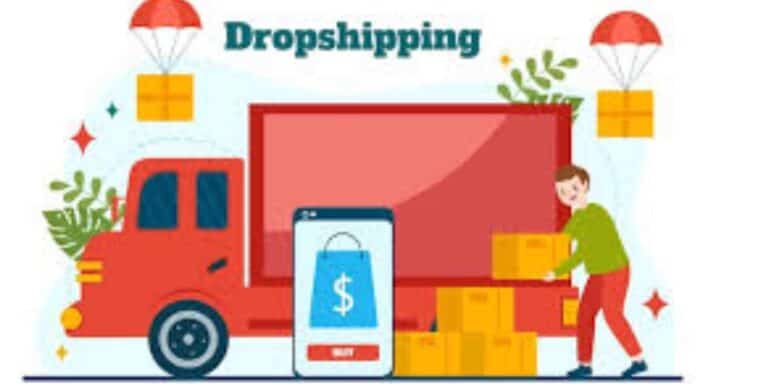How to start dropshipping business without investment? (No ads, no risk)
Dropshipping has become such a business model in today’s digital era in which you can start your online business without big investment. In this you do not need to manage physical inventory, rather the product is sent directly from the supplier to the customer. Come, in this article we will understand step-by-step how you can start a dropshipping business without spending a lot of money and without being dependent on ads.

What is Dropshipping?
Dropshipping is a business model where you sell products through your online store without holding any physical inventory. When a customer places an order, you forward it directly to the supplier, who then delivers the product to the customer.
Dropshipping is a retail business model where the seller does not keep products in stock but instead markets and sells products that are fulfilled and shipped directly by a third-party supplier or manufacturer to the customer. The seller acts as a middleman, handling marketing, customer service, and sales while the supplier manages inventory, packaging, and shipping. This model allows entrepreneurs to start an online store with minimal upfront investment, as they don’t need to purchase inventory or manage warehousing.
Key Features of Dropshipping
- No Inventory Management: The seller doesn’t hold physical stock; products are stored by suppliers.
- Low Startup Costs: Minimal investment is needed since there’s no need for warehouses, physical stores, or bulk inventory purchases.
- Order Fulfillment: When a customer places an order, the seller forwards it to the supplier, who ships the product directly to the customer.
- Profit Margin: The seller sets the retail price, pays the supplier’s wholesale price, and keeps the difference as profit.
- Product Variety: Sellers can offer a wide range of products without investing in inventory, as they rely on suppliers’ catalogs.
How Dropshipping Works
- Setup: The seller creates an online store (e.g., on Shopify, WooCommerce) and lists products from a supplier’s catalog.
- Marketing: The seller promotes products through digital marketing (e.g., social media, SEO, ads on platforms like X or Google).
- Order Placement: A customer purchases a product from the seller’s store.
- Order Forwarding: The seller sends the order details and payment (wholesale price) to the supplier.
- Fulfillment: The supplier ships the product directly to the customer, often with the seller’s branding (e.g., custom packaging).
- Customer Service: The seller handles customer inquiries, returns, or issues, while the supplier focuses on logistics.
Benefits of Dropshipping for Skyrocketing Profits
Tying this to your earlier query about real-time data and profitability (and referencing My11Circle for context), dropshipping leverages real-time data to maximize profits in ways similar to how My11Circle uses data for user engagement. Below are key benefits, structured for beginner to advanced audiences:
- Low Overhead Costs:
- Beginner: You don’t need to buy products upfront or rent a warehouse, so you can start a business with just a laptop and internet, keeping costs low.
- Intermediate: Dropshipping eliminates expenses like inventory storage, reducing financial risk. For example, a dropshipping store selling trending phone accessories can launch with less than $500, compared to thousands for traditional retail.
- Advanced: By avoiding inventory costs, businesses can allocate budgets to high-ROI activities like real-time ad campaigns (e.g., Google Ads or X promotions), similar to My11Circle’s targeted IPL campaigns. Real-time analytics on ad performance can optimize spend, increasing profit margins.
- Profit Impact: Lower costs mean higher margins (e.g., 20-50% per sale), enabling reinvestment into marketing for exponential growth.
- Scalability with Minimal Risk:
- Beginner: You can sell as many products as you want without worrying about stocking them, making it easy to grow your store.
- Intermediate: Dropshipping allows rapid scaling by adding new products from suppliers’ catalogs without logistical constraints. For instance, a store can test trending products (e.g., fitness gear) based on real-time social media trends on X.
- Advanced: Real-time data from platforms like Shopify Analytics or Google Trends helps identify high-demand products instantly, enabling dynamic catalog updates. Automated tools (e.g., Oberlo, Spocket) integrate with suppliers to scale order fulfillment seamlessly, similar to My11Circle’s real-time contest scaling during IPL matches.
- Profit Impact: Scalability without proportional cost increases drives higher sales volumes, boosting revenue.
- Real-Time Market Adaptability:
- Beginner: You can quickly change what you sell based on what’s popular, like switching from winter jackets to summer hats if sales data shows a trend.
- Intermediate: Real-time analytics tools (e.g., Google Analytics, Hotjar) track customer behavior, allowing sellers to pivot to trending products or adjust pricing instantly. For example, a dropshipper can use real-time X post analysis to spot trending gadgets and list them within hours.
- Advanced: Real-time data pipelines (e.g., using APIs from AliExpress or CJ Dropshipping) sync product availability and pricing, while machine learning models predict demand based on web searches or social media sentiment. This mirrors My11Circle’s use of real-time user data to optimize contest offerings.
- Profit Impact: Quick adaptation to market trends maximizes sales during peak demand, increasing revenue.
- Enhanced Customer Experience with Real-Time Data:
- Beginner: Real-time data helps you know what customers like, so you can offer better products or faster responses to their questions.
- Intermediate: Real-time tracking of customer interactions (e.g., via live chat tools like Tawk.to) enables personalized offers, such as discounts for cart abandonment, increasing conversions. For example, a dropshipping store can use real-time data to send targeted emails during a customer’s browsing session.
- Advanced: Real-time customer data integration with CRM systems (e.g., HubSpot) and AI-driven recommendation engines personalizes the shopping experience, similar to My11Circle’s personalized contest recommendations. WebSockets enable live order tracking, enhancing customer trust.
- Profit Impact: Higher conversion rates (e.g., 2-5% increase) and repeat purchases boost revenue and customer lifetime value.
- Global Reach with Low Investment:
- Beginner: You can sell to customers worldwide without owning a store, as suppliers handle shipping anywhere.
- Intermediate: Dropshipping platforms connect sellers with global suppliers (e.g., AliExpress, Printful), enabling sales in multiple markets without local infrastructure. Real-time currency conversion tools ensure accurate pricing across regions.
- Advanced: Real-time logistics data from suppliers (e.g., via ShipStation APIs) provides accurate shipping estimates, while geo-targeting ads based on real-time location data (e.g., from Google Ads) optimizes marketing. This global scalability mirrors My11Circle’s ability to attract users across India with real-time IPL promotions.
- Profit Impact: Access to global markets increases sales potential, driving higher profits.
Read more:
- Top 5 Undervalued Altcoins to Buy Before the Next Crypto Bull Run
- Best Crypto Wallets for Secure Long-Term Investment Storage
How Dropshipping Uses Real-Time Data
Dropshipping is an e-commerce business model where the retailer doesn’t hold inventory. Instead, when a customer places an order, the retailer purchases the product from a third-party supplier (typically a wholesaler or manufacturer) who then ships it directly to the customer. Real-time data plays a critical role in optimizing dropshipping operations, enhancing customer experience, and maximizing profitability. Below is a detailed breakdown of how real-time data is used in dropshipping, from basics to advanced applications.
Basics of Real-Time Data in Dropshipping
Real-time data refers to information that is collected, processed, and made available immediately or with minimal delay. In dropshipping, real-time data enables retailers to make informed decisions quickly, respond to market changes, and streamline operations.
1. What Types of Real-Time Data Are Used in Dropshipping?
- Inventory Levels: Data on stock availability from suppliers to avoid selling out-of-stock items.
- Product Pricing: Real-time updates on supplier pricing to adjust retail prices dynamically.
- Customer Behavior: Data on website traffic, product views, cart activity, and purchases.
- Market Trends: Insights into trending products, search queries, and competitor pricing.
- Order Status: Updates on order processing, shipping, and delivery from suppliers.
- Marketing Metrics: Performance data from ads (click-through rates, conversions, cost-per-click).
- Logistics Data: Real-time shipping rates, carrier availability, and delivery timelines.
2. Why Real-Time Data Matters in Dropshipping
- Prevent Overselling: Ensures products are in stock before orders are accepted.
- Dynamic Pricing: Adjusts prices based on supplier costs or market demand.
- Customer Satisfaction: Provides accurate shipping times and order updates.
- Quick Decision-Making: Helps identify trending products or failing strategies instantly.
- Cost Efficiency: Optimizes ad spend and reduces losses from outdated information.
3. Basic Tools for Accessing Real-Time Data
- E-commerce Platforms: Shopify, WooCommerce, or BigCommerce integrate with apps for real-time inventory and order tracking.
- Dropshipping Apps: Oberlo, Spocket, or AliExpress Dropshipping sync supplier data with your store.
- Analytics Tools: Google Analytics for real-time website traffic and user behavior.
- APIs: Supplier APIs provide live data on inventory, pricing, and shipping.
- Ad Platforms: Meta Ads, Google Ads, or TikTok Ads offer real-time campaign performance.
Intermediate Use of Real-Time Data in Dropshipping
At an intermediate level, dropshippers leverage real-time data to optimize operations, improve marketing, and enhance customer experience.
1. Real-Time Inventory Management
- How It Works: Dropshipping apps sync with supplier databases to update stock levels in real time. For example, if a supplier runs out of a product, the store automatically marks it as out-of-stock.
- Benefits:
- Avoids overselling, which can lead to refunds and negative reviews.
- Enables multi-supplier strategies by tracking inventory across multiple sources.
- Tools: DSers, Inventory Source, or Modalyst provide real-time inventory syncing.
- Example: A Shopify store using Oberlo gets instant alerts when AliExpress supplier stock drops below a threshold, pausing sales until restocked.
2. Dynamic Pricing Strategies
- How It Works: Real-time data on supplier costs, competitor prices, and market demand allows dropshippers to adjust prices automatically.
- Benefits:
- Stay competitive by matching or undercutting competitors.
- Maximize margins during high-demand periods.
- Avoid losses when supplier prices increase.
- Tools: Price monitoring tools like Prisync or Repricer integrate with e-commerce platforms to adjust prices in real time.
- Example: If a competitor lowers the price of a trending gadget, the dropshipper’s store automatically reduces its price by 5% to stay competitive.
3. Real-Time Marketing Optimization
- How It Works: Ad platforms provide real-time metrics on campaign performance, allowing dropshippers to adjust targeting, budgets, or creatives instantly.
- Benefits:
- Scale high-performing ads or pause underperforming ones.
- Target specific audiences based on live user behavior (e.g., retargeting cart abandoners).
- Tools: Facebook Ads Manager, Google Ads, or Klaviyo for email marketing.
- Example: A dropshipper notices a TikTok ad for a pet product has a high click-through rate but low conversions. They tweak the landing page in real time to improve sales.
4. Customer Experience Enhancement
- How It Works: Real-time order tracking and communication keep customers informed about their purchase status.
- Benefits:
- Reduces customer inquiries about order status.
- Builds trust with transparent shipping updates.
- Tools: AfterShip, Tracktor, or 17Track provide real-time shipping updates.
- Example: A customer receives an email with a tracking link that updates in real time as the package moves from the supplier to their doorstep.
Advanced Use of Real-Time Data in Dropshipping
At an advanced level, dropshippers use real-time data for predictive analytics, automation, and scaling their businesses globally.
1. Predictive Analytics for Trend Spotting
- How It Works: Machine learning algorithms analyze real-time data (e.g., search trends, social media mentions, competitor sales) to predict which products will trend.
- Benefits:
- Stay ahead of the market by launching products before competitors.
- Reduce risks of investing in unprofitable niches.
- Tools: TrendHunter, Jungle Scout, or Sell The Trend for product research.
- Example: A dropshipper uses real-time Google Trends data to identify a surge in searches for “foldable yoga mats” and quickly adds them to their store.
2. Automated Order Fulfillment
- How It Works: Real-time APIs connect e-commerce stores with suppliers to automate order placement, tracking, and updates.
- Benefits:
- Saves time by eliminating manual order processing.
- Reduces errors in order fulfillment.
- Tools: AutoDS, Dropified, or custom API integrations.
- Example: When a customer orders a phone case, the store automatically sends the order details to the supplier, who ships it without manual intervention.
3. Real-Time Fraud Detection
- How It Works: Real-time data on customer behavior (e.g., IP address, purchase patterns) is analyzed to flag potential fraudulent orders.
- Benefits:
- Prevents chargebacks and financial losses.
- Protects the store’s reputation with payment processors.
- Tools: Signifyd, FraudLabs Pro, or Shopify Fraud Protect.
- Example: A sudden order for 10 high-value items from a new customer triggers a real-time fraud alert, prompting manual review before processing.
4. Global Supply Chain Optimization
- How It Works: Real-time logistics data (e.g., shipping rates, carrier performance, customs delays) helps dropshippers choose the best suppliers and shipping methods.
- Benefits:
- Reduces shipping times and costs.
- Improves customer satisfaction in international markets.
- Tools: Easyship, ShipStation, or Route for logistics management.
- Example: A dropshipper uses real-time carrier data to switch from a slow supplier in China to a faster one in the US for orders placed by American customers.
5. Hyper-Personalized Marketing
- How It Works: Real-time customer data (e.g., browsing history, location, device) is used to deliver personalized product recommendations, emails, or ads.
- Benefits:
- Increases conversion rates.
- Enhances customer retention.
- Tools: Omnisend, Dynamic Yield, or Klaviyo for personalization.
- Example: A customer browsing fitness gear on a dropshipping site receives a real-time pop-up offering a 10 off voucher for yoga equipment, based on their recent views.
6. Real-Time Competitor Monitoring
- How It Works: Tools scrape competitor websites or social media for real-time data on their pricing, promotions, or product launches.
- Benefits:
- Enables rapid response to competitor strategies.
- Identifies gaps in competitor offerings to exploit.
- Tools: ImportYeti, SimilarWeb, or AdSpy for competitor analysis.
- Example: A dropshipper notices a competitor’s flash sale on eco-friendly water bottles and launches a similar promotion with faster shipping to attract customers.
Challenges of Using Real-Time Data in Dropshipping
- Data Overload: Too much data can overwhelm small businesses without proper tools or expertise.
- Cost: Advanced tools for real-time analytics or APIs often require paid subscriptions.
- Supplier Dependence: Real-time data relies on suppliers providing accurate, up-to-date feeds.
- Technical Complexity: Setting up integrations and APIs requires technical skills or developer support.
- Privacy Regulations: Handling customer data must comply with laws like GDPR or CCPA, limiting data use.
Best Practices for Using Real-Time Data
- Start Simple: Begin with basic tools like Oberlo or Google Analytics before investing in advanced solutions.
- Automate Processes: Use apps or APIs to reduce manual data monitoring.
- Monitor Key Metrics: Focus on inventory, sales, and ad performance to avoid data overload.
- Test and Iterate: Use real-time insights to run small-scale tests before scaling strategies.
- Stay Compliant: Ensure data privacy practices align with regulations like GDPR.
- Integrate Scalable Tools: Choose platforms that can handle increased data as your business grows.
Conclusion
Real-time data transforms dropshipping from a reactive business model into a proactive, efficient, and data-driven operation. At the basic level, it prevents overselling and improves customer trust. Intermediate applications optimize pricing and operations, while advanced techniques like predictive analytics and automation drive scalability and profitability. By leveraging the right tools and strategies, dropshippers can use real-time data to stay competitive in a fast-paced e-commerce landscape.
If you need help setting up specific tools or want a chart to visualize real-time data metrics (e.g., sales trends or ad performance), let me know!
- Real-Time Analytics:
- Dropshippers use tools like Shopify Analytics to track real-time sales, traffic, and conversion rates, identifying top-performing products instantly.
- Example: A dropshipping store notices a spike in smartwatch sales via real-time data and increases ad spend on X to capitalize on the trend, similar to My11Circle’s real-time contest adjustments.
- Real-Time Monitoring:
- Monitoring tools track website uptime, order processing, and supplier performance to ensure smooth operations. For instance, a dropshipper monitors supplier stock levels in real time to avoid selling out-of-stock items.
- Example: Like My11Circle’s monitoring of app performance during IPL matches, dropshippers use tools like Datadog to prevent website crashes during traffic surges.
- Continuous Improvement:
- Real-time A/B testing of product pages or ads helps optimize conversions. For example, a dropshipper tests two ad creatives on X, using real-time click-through data to select the better-performing one.
- Example: My11Circle refines contest formats based on real-time user data; similarly, dropshippers refine product listings based on live customer feedback.
Visualizing Dropshipping Profit Potential
To illustrate how real-time data drives dropshipping profits, here’s a chart showing hypothetical sales and ad spend ROI for a dropshipping store during a trending product launch, leveraging real-time analytics to optimize marketing.

Interpretation:
- The chart shows sales revenue and ad spend ROI increasing over five days as the dropshipper uses real-time data to optimize ads (e.g., targeting trending products on X).
- This mirrors My11Circle’s use of real-time data to boost contest entries during IPL matches, driving revenue.
Challenges of Dropshipping
- Low Margins: High competition can reduce profit margins (typically 10-30%) unless optimized with real-time data.
- Supplier Reliability: Dependence on third-party suppliers can lead to delays or quality issues, requiring real-time monitoring to mitigate.
- Customer Service: Handling returns or complaints falls on the seller, necessitating real-time communication tools.
- Marketing Costs: Success relies on effective marketing, which requires real-time analytics to optimize ad spend.
Dropshipping is a low-risk, scalable business model that leverages real-time data to drive profits through low overhead, market adaptability, and enhanced customer experiences. Like My11Circle, dropshipping businesses use real-time analytics, monitoring, and continuous improvement to optimize operations and marketing, maximizing revenue. The chart above illustrates how real-time data fuels sales growth, similar to My11Circle’s IPL-driven revenue spikes.
If you’d like a deeper dive into dropshipping strategies, a comparison with My11Circle’s data-driven approach, or a search for X posts about successful dropshipping stores, let me know!
Benefits of Dropshipping
- Low Investment: Start a business without the risk of holding inventory.
- Flexibility: Work from anywhere with just an internet connection.
- Wide Product Range: Offer diverse products without stocking them.
Drawbacks of Dropshipping
- Low Profit Margins: As a middleman, profit margins can be slim.
- Supplier Dependency: Your reputation relies on the supplier’s reliability.
- Competition: It’s a popular model, leading to high competition.
How to Start Dropshipping Without Investment?
Step 1: Choose a Niche
First, select a niche you’re passionate about with manageable competition. Keep these points in mind:
- Market Research: Use Google Trends, social media, and forums to research.
- Demand Analysis: Check how much interest there is for the product.
- Personal Interest: Choose a niche you’re genuinely passionate about to stay motivated.
Real-World Example:
Rohan, a small business owner, chose fitness accessories as his niche. Research showed growing demand for home fitness products, making it a strategic choice.
Step 2: Find Reliable Suppliers
Suppliers are the backbone of your dropshipping business. To start without investment, find suppliers who don’t require minimum orders.
- Online Platforms: Explore platforms like AliExpress, Oberlo, or SaleHoo for reliable suppliers.
- Direct Contact: Reach out to suppliers directly via their websites.
- Reviews & Ratings: Always check supplier reviews and ratings.
Tips:
- Focus on product quality and shipping times.
- Build relationships with suppliers who offer good customer support.
Step 3: Use Free E-Commerce Platforms
To start dropshipping without investment, leverage free e-commerce platforms:
- Shopify Free Trial: Use Shopify’s free trial to set up your store.
- WooCommerce: A free plugin for WordPress websites.
- Social Media Stores: Sell products directly via Facebook or Instagram shops without a website.
Step 4: Adopt Organic Marketing Strategies
Without ads, organic marketing is key to building your online presence:
- SEO (Search Engine Optimization): Use relevant keywords in your website and product descriptions.
- Social Media Engagement: Post regularly on Instagram, Facebook, and LinkedIn.
- Content Marketing: Highlight product benefits through blog posts, videos, and tutorials–
Real-World Example:
Neha used Instagram to market her eco-friendly kitchen products dropshipping store. By sharing recipes and eco-friendly tips, she grew her followers and boosted sales.
Step 5: Focus on Customer Service and Trust
Customer service is critical to earning trust:
- Quick Response: Address customer queries promptly.
- Transparency: Clearly communicate shipping and return policies.
- Feedback Collection: Use customer feedback to improve your business.
Tips:
- Add an FAQ section and live chat option to your website.
- Highlight customer reviews on social media.
Running a Business Without Ads: The Power of Organic Traffic
You can grow your business without paid ads by generating organic traffic. Here are effective strategies:
SEO Strategies
- Keyword Research: Use free tools like Ubersuggest or Google Keyword Planner.
- Quality Content: Publish high-quality blog posts, guides, and tutorials regularly.
- Backlinking: Seek backlinks from influencers and related websites.
Social Media Optimization
- Hashtags: Use relevant hashtags to reach a wider audience.
- Engagement: Interact with followers and respond to comments.
- Collaborations: Partner with influencers to promote your products.
Email Marketing
- Newsletter: Send regular newsletters with new arrivals and special offers.
- Lead Magnets: Offer free eBooks or discount codes to build your email list.
- Personalization: Personalize emails to boost engagement.
Content Marketing
- Blogging: Write detailed blog posts explaining product benefits and use cases.
- Tutorials: Create videos or step-by-step guides to demonstrate product usage.
- Guest Posting: Share your store’s link through guest posts on niche-related blogs.
How to Run Dropshipping Without Risk?
To minimize risks in dropshipping, manage your processes carefully. Here are practical tips:
1. Supplier Verification
- Trial Orders: Place trial orders to check supplier reliability.
- Reviews: Thoroughly review supplier ratings and feedback.
- Backup Supplier: Always have multiple reliable suppliers as alternatives.
2. Clear Policies
- Return Policy: Draft a clear and simple return policy.
- Shipping Policy: Specify shipping times and tracking details.
- Refund Policy: Ensure refund and cancellation policies are transparent.
3. Test Products
- Quality Check: Order products yourself to verify quality if possible.
- Packaging Inspection: Check packaging and shipping materials.
- User Experience: Test the product experience yourself.
4. Legal Considerations
- Business Registration: Register your business if required.
- Taxation: Handle tax calculations and declarations properly.
- Terms & Conditions: Display clear Terms & Conditions and Privacy Policy on your website.
Real-World Case Study: Sushant’s Success Story
Sushant, from a small town, started his dropshipping business without significant investment, focusing on organic skincare products. His approach included:
- Supplier Selection: Partnered with a trusted supplier.
- Organic Marketing: Shared informative posts and customer testimonials on social media.
- Customer Engagement: Responded promptly to queries and offered free samples.
Through consistent organic marketing, Sushant built customer trust and a steady following, turning his business into a successful brand loved by his local community.
Leveraging Technology
Using the right technology is crucial for dropshipping. Several free tools can streamline your business:
Inventory Management Tools
- Oberlo: A popular tool for Shopify to import products easily.
- Spocket: Highlights US and EU suppliers for faster shipping.
Order Tracking Systems
- AfterShip: Simplifies order tracking and customer notifications.
- ShipStation: A reliable system to streamline shipping.
Analytics and Reporting
- Google Analytics: A free tool to understand website traffic and customer behavior.
- Facebook Insights: Useful for analyzing social media marketing performance.
Tips for Long-Term Success
For sustainable growth in dropshipping, long-term planning is essential. Here are some tips:
Continuous Learning
- Webinars & Workshops: Attend online events to gain knowledge from industry experts.
- Books & Courses: Study dropshipping and e-commerce resources.
- Forums & Communities: Learn from other entrepreneurs on platforms like Reddit, Quora, and Facebook groups.
Adaptability
- Market Trends: Regularly monitor trends and update your product portfolio.
- Customer Feedback: Take feedback seriously to improve services.
- Innovation: Adopt new ideas and solutions to stay ahead of competitors.
Financial Planning
- Reinvest Profits: Reinvest a portion of profits into business improvements.
- Budget Management: Track expenses and avoid unnecessary costs.
- Emergency Fund: Maintain a small emergency fund for unexpected situations.
FAQs
What is dropshipping?
Dropshipping is a business model where you sell products online without holding inventory. When a customer orders, the supplier delivers the product directly to them.
Can I start dropshipping without investment?
Yes, you can start with free e-commerce platforms, organic marketing, and reliable suppliers without significant investment.
How can I generate traffic through organic marketing?
Use SEO, social media engagement, content marketing, and email marketing to reach your target audience organically.
How can I ensure supplier reliability?
Check supplier reviews, place trial orders, and keep backup suppliers ready to handle any issues.
Conclusion
Dropshipping offers a platform to start an online business without significant investment, ads, or high risks. By choosing the right niche, partnering with reliable suppliers, using free e-commerce platforms, and implementing effective organic marketing strategies, you can achieve sustainable growth. As seen in real-world examples, consistent effort, innovative thinking, and a customer-centric approach are key to long-term success. With some research and trial in the beginning, you can gradually build a successful dropshipping empire.
Now is the time to take action. Trust your passion and research, follow the step-by-step strategy, and you’ll see how much impact you can create without investment. Happy dropshipping, and remember, every new day brings a new opportunity!







